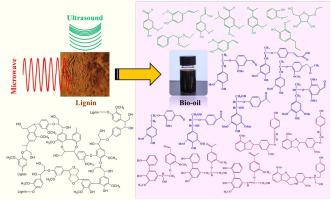Industrial Crops and Products ( IF 5.6 ) Pub Date : 2021-02-09 , DOI: 10.1016/j.indcrop.2021.113300 Ashutosh Agarwal , Young-Tae Jo , Jeong-Hun Park

|
In this study, the simultaneous effect of microwave-ultrasound (MW + US) irradiations was compared with those of microwave (MW) and ultrasound (US) applied individually for the depolymerization of Kraft lignin in a hybrid microwave-ultrasound high pressure chemical reactor. The bio-oils obtained upon depolymerization were analyzed by GC–MS, CHNS, MALDI-TOF-MS, 2D-HSQC NMR, TGA and FTIR techniques. The highest bio-oil yield of 48.2% was obtained upon depolymerization of Kraft lignin with hybrid MW + US irradiations for 1 h under autogenous pressure while only 42.1% and 25.5% bio-oil yields were obtained for MW and US irradiations, respectively. MALDI-TOF MS spectra suggested the presence of significant amount of dimers in the bio-oil obtained over hybrid MW + US process than US and MW processes. The simultaneous effect of MW and US reduced the repolymerization of reaction intermediates thus favoring relatively low residue and high bio-oil yield. 2D-HSQC NMR demonstrated considerable degradation of the representative inter-unit linkages (β-O-4 and β-5). The HHVBoie of the bio-oils obtained over US (29.28 MJ/Kg) and MW + US (29.21 MJ/Kg) irradiations were quite comparable. Although the thermal stability of the bio-oils followed the order MW > MW + US > US, the bio-oil obtained over hybrid MW + US was superior in both quality and quantity than obtained over MW and US irradiations.
中文翻译:

杂粮-超声-超声波辅助的牛皮纸木质素无催化剂解聚为生物油
在这项研究中,将微波-超声波(MW + US)照射的同时效果与微波(MW)和超声(US)分别用于牛皮纸木质素在混合微波-超声波高压化学反应器中解聚的效果进行了比较。解聚后获得的生物油通过GC-MS,CHNS,MALDI-TOF-MS,2D-HSQC NMR,TGA和FTIR技术进行了分析。在自生压力下,用杂合MW + US辐照对牛皮纸木质素解聚1 h,可获得最高的生物油收率48.2%,而MW和US辐照分别仅获得42.1%和25.5%的生物油收率。MALDI-TOF MS光谱表明,与美国和MW流程相比,通过MW + US混合流程获得的生物油中存在大量的二聚体。MW和US的同时作用减少了反应中间体的再聚合,因此有利于较低的残留物和较高的生物油产率。2D-HSQC NMR证实了代表性的单元间键(β-O-4和β-5)的降解。HHV•伯伊在美国获得的生物油(29.28兆焦/千克)和MW +美国(29.21兆焦/千克)照射是相当具有可比性。尽管生物油的热稳定性遵循MW> MW + US> US的顺序,但是通过混合MW + US获得的生物油在质量和数量上均优于通过MW和US辐照获得的生物油。











































 京公网安备 11010802027423号
京公网安备 11010802027423号